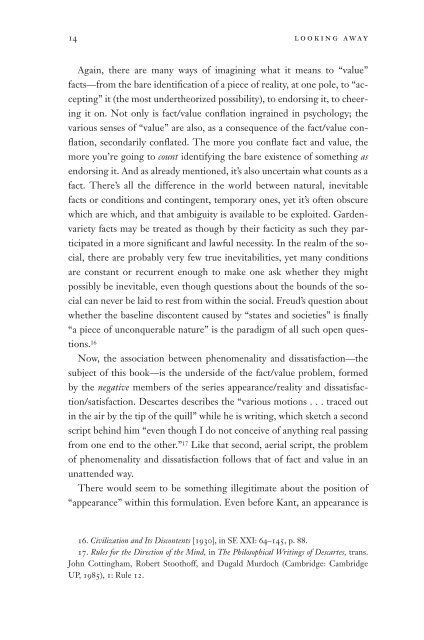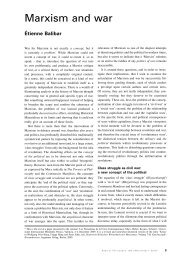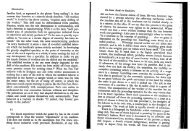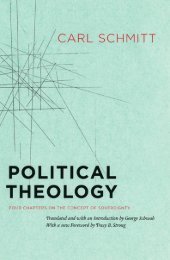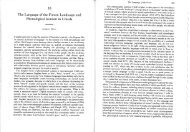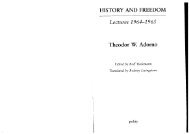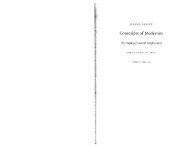Terada - Looking Away (Selections).pdf - Townsend Humanities Lab
Terada - Looking Away (Selections).pdf - Townsend Humanities Lab
Terada - Looking Away (Selections).pdf - Townsend Humanities Lab
Create successful ePaper yourself
Turn your PDF publications into a flip-book with our unique Google optimized e-Paper software.
14 looking away<br />
Again, there are many ways of imagining what it means to “value”<br />
facts—from the bare identification of a piece of reality, at one pole, to “accepting”<br />
it (the most undertheorized possibility), to endorsing it, to cheering<br />
it on. Not only is fact/value conflation ingrained in psychology; the<br />
various senses of “value” are also, as a consequence of the fact/value conflation,<br />
secondarily conflated. The more you conflate fact and value, the<br />
more you’re going to count identifying the bare existence of something as<br />
endorsing it. And as already mentioned, it’s also uncertain what counts as a<br />
fact. There’s all the difference in the world between natural, inevitable<br />
facts or conditions and contingent, temporary ones, yet it’s often obscure<br />
which are which, and that ambiguity is available to be exploited. Gardenvariety<br />
facts may be treated as though by their facticity as such they participated<br />
in a more significant and lawful necessity. In the realm of the social,<br />
there are probably very few true inevitabilities, yet many conditions<br />
are constant or recurrent enough to make one ask whether they might<br />
possibly be inevitable, even though questions about the bounds of the social<br />
can never be laid to rest from within the social. Freud’s question about<br />
whether the baseline discontent caused by “states and societies” is finally<br />
“a piece of unconquerable nature” is the paradigm of all such open questions.<br />
16<br />
Now, the association between phenomenality and dissatisfaction—the<br />
subject of this book—is the underside of the fact/value problem, formed<br />
by the negative members of the series appearance/reality and dissatisfaction/satisfaction.<br />
Descartes describes the “various motions ...traced out<br />
in the air by the tip of the quill” while he is writing, which sketch a second<br />
script behind him “even though I do not conceive of anything real passing<br />
from one end to the other.” 17 Like that second, aerial script, the problem<br />
of phenomenality and dissatisfaction follows that of fact and value in an<br />
unattended way.<br />
There would seem to be something illegitimate about the position of<br />
“appearance” within this formulation. Even before Kant, an appearance is<br />
16. Civilization and Its Discontents [1930], in SE XXI: 64–145, p. 88.<br />
17. Rules for the Direction of the Mind, in The Philosophical Writings of Descartes, trans.<br />
John Cottingham, Robert Stoothoff, and Dugald Murdoch (Cambridge: Cambridge<br />
UP, 1985), 1: Rule 12.


